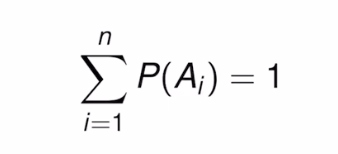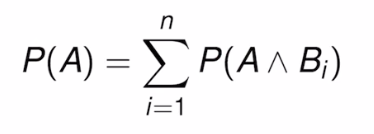Machine Learning Terms
1/17
There's no tags or description
Looks like no tags are added yet.
Name | Mastery | Learn | Test | Matching | Spaced |
|---|
No study sessions yet.
18 Terms
sample space
a set of possible outcomes in your domain.
random variable
a function defined over the sample space S.
Event
a subset of S.
Probability
a real function defined over the events in the sample space
probability has value between 0 and 1.
probability has value between 0 and 1 equation

probability of true is 1
an event in which all outcomes occur; i.e. either heads or tails occurs

probability of false is 0
an event in which no outcomes occur; i.e. neither heads or tails occurs

equation of the probability of A or B
b/c the probability of a&b occurs twice w/in a venn diagram one must be subtracted. the probability of a plus the probability of b minus the prob. of a&b equals the prob of a or b.

Mutually exclusive events
one event doesn’t include the outcome of another event (if a coin lands on heads then it hasn’t landed on tails—two mutually exclusive events).
Probability mass function
all possible events in sample space S should add up to 1. (i.e., P(A)= heads & P(A)=tails would both equal 1 b/c coinds eitehr lande on heads or tails)

P, Ai
P= probability mass function
Ai= a specific value in the discretization of a continuous quantity
Sum Rule
used to prove that P(A)=1-P(notA) and P(A)=P(A&B)+P(A¬B) recall that A and notA are mutually exclusive events; if one occurs the other one doesn’t)

supervised learning
identify, based on previous input-output examples of this function, which class the vector can be mapped onto. standard formulation: classification
unsupervised learning
given a set of inputs w/ no output mapped to them, find a pattern in the inputs via clustering (grouping instances).
semi-supervised learning
labeled and unlabeled functions to generate an appropriate function.
reinforcement learning
algorithm is taught a policy of how to act given an observation. after the agent causes the mechanism there is a feedback mechanism it uses to understand its mistakes and improve future reactions.
Machine learning algorithms have the following in common
representation (how is data represented/what hypothesis space does it belong to?), evaluation (helps algorithm determine if its on the right path/ how its performance can be improved), and optimization (how to optimize algorithms for the data in question).
applications for supervised learning
situations where human experts are hard to find; situations where humans can do the task but can’t describe it; situations where y output changes quickly due to new info; situations where a customer requires a unique function.